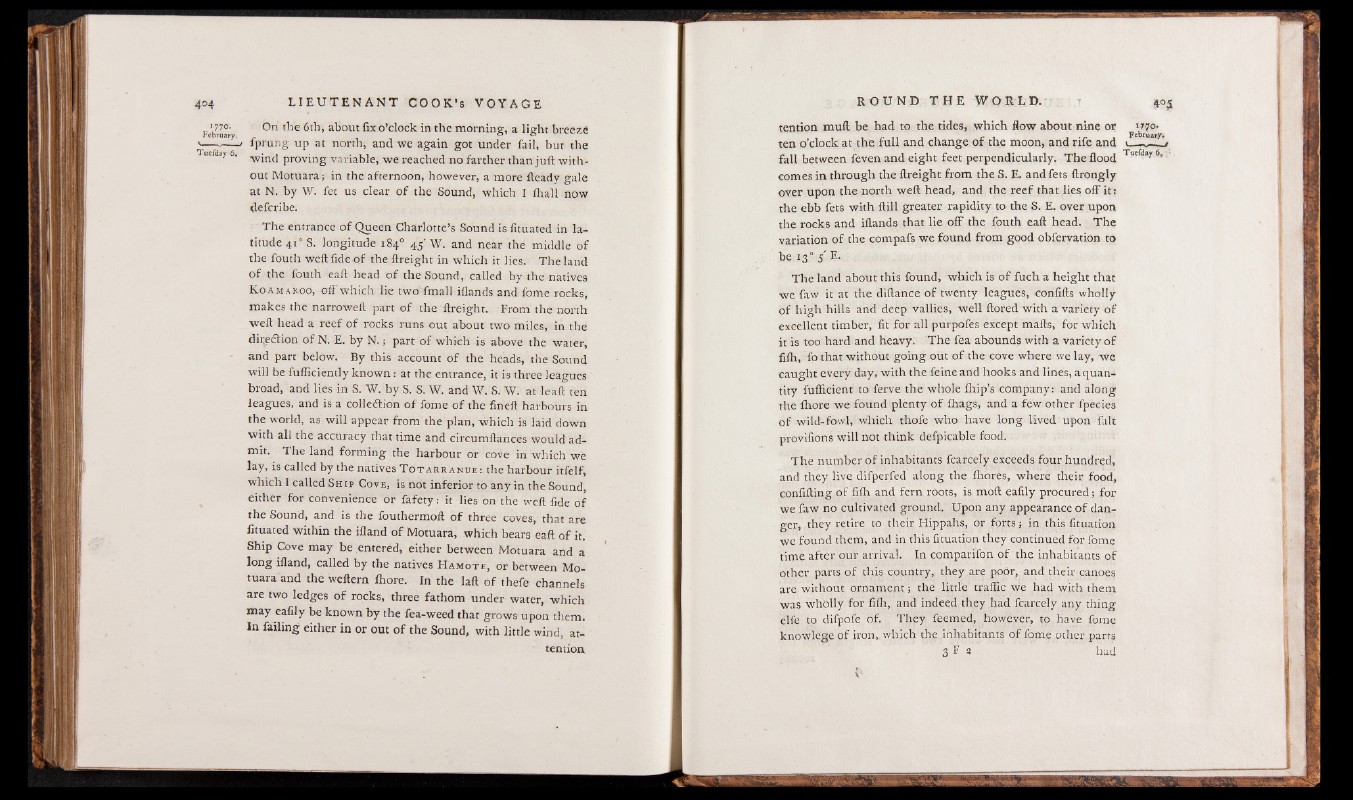
Feb7ru°' ° n *'le <^t^’ a'J0in fix o’clock in the morning, a light breeze
£— ,— h fprung up at north, and we again got under fail, but the
uefday 6. wjnc] prov;ng yaviable, we reached no farther than juft without
Motuara; in the afternoon, however, a more fteady gale
at N. by W. fet us clear of the Sound, which I fhall now
defcribe.
The entrance of Queen Charlotte’s Sound is fituated in latitude
410 S. longitude 184° 45' W. and near the middle of
the fouth weft fide o f the ftreight in which it lies. The land
of the fouth eaft head of the Sound, called by the natives
K oamaroo, -off which lie two fmall iflands and fome rocks,
makes the narroweft paTt of the ftreight. From the north
weft head a reef of rocks runs out about two miles, in the
diredlion of N. E. by N .; part of which is above the water,
and part below. By this account of the heads, the Sound
will be fufficiently known! at the entrance, it is three leagues
broad, and lies in S. W. by S. S. W. and W. S. W. at leaft ten
leagues, and is a colledtion of fome of the fineft harbours in
the world, as will appear from the plan, which is laid down
with all the accuracy that time and circumftances would admit.
The land forming the harbour or cove in which we
lay, is called by the natives T otarranue : the harbour itfelf,
which I called Ship Cove, is not inferior to any in the Sound,
either for convenience or fafety: it lies on the weft fide of
the Sound, and is the fouthermoft of three coves, that are
fituated within the ifland of Motuara, which bears eaft of it.
Ship Cove may be entered, either between Motuara and a
long ifland, called by the natives Hamote, or between Motuara
and the weftern Ihore. In the laft of thefe channels
are two ledges of rocks, three fathom under water, which
may eafily be known by the fea-weed that grows upon them.
In failing either in or out of the Sound, with little wind, attention.
tention muft be had to the tides, which flow about nine or
ten o’clock at the full and change of the moon, and rife and
fall between feven and eight feet perpendicularly. The flood
comes in through the ftreight from the S. E, and fets ftrongly
over upon the north weft head, and the reef that lies off it:
the ebb fets with ftill greater rapidity to the S. E. over upon
the rocks and iflands that lie off the fouth eaft head. The
variation of the compafs we found from good obfervation to
be 130 5' E.
The land about this found, which is of fuch a height that
we faw it at the diftance of twenty leagues, confifts wholly
of high hills and deep vallies, well ftored with a variety of
excellent timber, fit for all purpofes except malls, for which
it is too hard and heavy. The fea abounds with a variety of
fifh, fo that without going out of the cove where we lay, we
caught every day, with the feineand hooks and lines, a quantity
fufficient to ferve the whole fhip’s company: and along
the fhore we found plenty of fhags, and a few other fpecies
of wild-fowl, which thofe who have long lived upon fait
provifions will not think defpicable food.
The number of inhabitants fcarcely exceeds four hundred,
and they live difperfed along the fliores, where their food,
confifting of fifh and fern roots, is moft eafily procured; for
we faw no cultivated ground. Upon any appearance of danger,
they retire to their Hippahs, or forts; in this fituation
we found them, and in this fituation they continued for fome
time after our arrival. In comparifon of the inhabitants of
other parts of this country, they are poor, and their canoes
are without ornament; the little traffic we had with them
was wholly for fifh, and indeed they had fcarcely any thing
elfe to difpofe of. They feemed, however, to have fome
knowlege of iron, which the inhabitants of fome other parts
3 f 3 " ’ ' " ' h a d